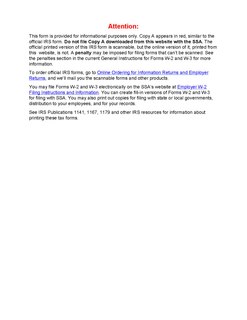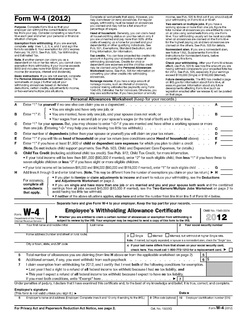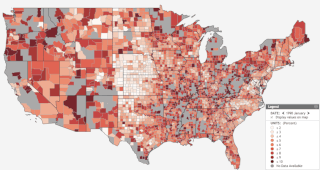Related Research Articles
A pay-as-you-earn tax (PAYE), or pay-as-you-go (PAYG) in Australia, is a withholding of taxes on income payments to employees. Amounts withheld are treated as advance payments of income tax due. They are refundable to the extent they exceed tax as determined on tax returns. PAYE may include withholding the employee portion of insurance contributions or similar social benefit taxes. In most countries, they are determined by employers but subject to government review. PAYE is deducted from each paycheck by the employer and must be remitted promptly to the government. Most countries refer to income tax withholding by other terms, including pay-as-you-go tax.

Payroll taxes are taxes imposed on employers or employees, and are usually calculated as a percentage of the salaries that employers pay their employees. By law, some payroll taxes are the responsibility of the employee and others fall on the employer, but almost all economists agree that the true economic incidence of a payroll tax is unaffected by this distinction, and falls largely or entirely on workers in the form of lower wages. Because payroll taxes fall exclusively on wages and not on returns to financial or physical investments, payroll taxes may contribute to underinvestment in human capital such as higher education.

The Federal Insurance Contributions Act is a United States federal payroll contribution directed towards both employees and employers to fund Social Security and Medicare—federal programs that provide benefits for retirees, people with disabilities, and children of deceased workers.
An independent contractor is a person, business, or corporation that provides goods or services under a written contract or a verbal agreement. Unlike employees, independent contractors do not work regularly for an employer but work as required, when they may be subject to law of agency. Independent contractors are usually paid on a freelance basis. Contractors often work through a limited company or franchise, which they themselves own, or may work through an umbrella company.
A professional employer organisation (PEO) is an outsourcing firm that provides services to small and medium-sized businesses (SMBs). Typically, the PEO offering may include human resource consulting, safety and risk mitigation services, payroll processing, employer payroll tax filing, workers' compensation insurance, health benefits, employers' practice and liability insurance (EPLI), retirement vehicles, regulatory compliance assistance, workforce management technology, and training and development. The PEO enters into a contractual co-employment agreement with its clientele. Through co-employment, the PEO becomes the employer of record (EoR) for tax purposes through filing payroll taxes under its own tax identification numbers. As the legal employer, the PEO is responsible for withholding proper taxes, paying unemployment insurance taxes and providing workers’ compensation coverage.
Three key types of withholding tax are imposed at various levels in the United States:

Employee benefits and benefits in kind include various types of non-wage compensation provided to employees in addition to their normal wages or salaries. Instances where an employee exchanges (cash) wages for some other form of benefit is generally referred to as a "salary packaging" or "salary exchange" arrangement. In most countries, most kinds of employee benefits are taxable to at least some degree. Examples of these benefits include: housing furnished or not, with or without free utilities; group insurance ; disability income protection; retirement benefits; daycare; tuition reimbursement; sick leave; vacation ; social security; profit sharing; employer student loan contributions; conveyancing; long service leave; domestic help (servants); and other specialized benefits.

Form W-2 is an Internal Revenue Service (IRS) tax form used in the United States to report wages paid to employees and the taxes withheld from them. Employers must complete a Form W-2 for each employee to whom they pay a salary, wage, or other compensation as part of the employment relationship. An employer must mail out the Form W-2 to employees on or before January 31. This deadline gives these taxpayers about 2 months to prepare their returns before the April 15 income tax due date. The form is also used to report FICA taxes to the Social Security Administration. The Form W-2, along with Form W-3, generally must be filed by the employer with the Social Security Administration by the end of February. Relevant amounts on Form W-2 are reported by the Social Security Administration to the Internal Revenue Service. In territories, the W-2 is issued with a two letter code indicating which territory, such as W-2GU for Guam. If corrections are made, it can be done on a W-2c.
Tax withholding, also known as tax retention, Pay-as-You-Go, Pay-as-You-Earn, or a Prélèvement à la source, is income tax paid to the government by the payer of the income rather than by the recipient of the income. The tax is thus withheld or deducted from the income due to the recipient. In most jurisdictions, tax withholding applies to employment income. Many jurisdictions also require withholding taxes on payments of interest or dividends. In most jurisdictions, there are additional tax withholding obligations if the recipient of the income is resident in a different jurisdiction, and in those circumstances withholding tax sometimes applies to royalties, rent or even the sale of real estate. Governments use tax withholding as a means to combat tax evasion, and sometimes impose additional tax withholding requirements if the recipient has been delinquent in filing tax returns, or in industries where tax evasion is perceived to be common.
California's Paid Family Leave (PFL) insurance program, which is also known as the Family Temporary Disability Insurance (FTDI) program, is a law enacted in 2002 that extends unemployment disability compensation to cover individuals who take time off work to care for a seriously ill family member or bond with a new minor child. If eligible, you can receive benefit payments for up to eight weeks. Payments are about 60 to 70 percent of your weekly wages earned 5 to 18 months before your claim start date. You will receive payments by debit card or check. Benefits equal approximately 70% of earnings and have a maximum per week, for a total of up to six weeks.

Income taxes in the United States are imposed by the federal government, and most states. The income taxes are determined by applying a tax rate, which may increase as income increases, to taxable income, which is the total income less allowable deductions. Income is broadly defined. Individuals and corporations are directly taxable, and estates and trusts may be taxable on undistributed income. Partnerships are not taxed, but their partners are taxed on their shares of partnership income. Residents and citizens are taxed on worldwide income, while nonresidents are taxed only on income within the jurisdiction. Several types of credits reduce tax, and some types of credits may exceed tax before credits. An alternative tax applies at the federal and some state levels.
For the Old Age, Survivors and Disability Insurance (OASDI) tax or Social Security tax in the United States, the Social Security Wage Base (SSWB) is the maximum earned gross income or upper threshold on which a wage earner's Social Security tax may be imposed. The Social Security tax is one component of the Federal Insurance Contributions Act tax (FICA) and Self-employment tax, the other component being the Medicare tax. It is also the maximum amount of covered wages that are taken into account when average earnings are calculated in order to determine a worker's Social Security benefit.

Form W-4 is an Internal Revenue Service (IRS) tax form completed by an employee in the United States to indicate his or her tax situation to the employer. The W-4 form tells the employer the correct amount of federal tax to withhold from an employee's paycheck.
Misclassification of employees as independent contractors is the way in which the United States classifies the problem of false self-employment. It can occur with respect to tax treatment or the Fair Labor Standards Act.

A cafeteria plan or cafeteria system is a type of employee benefit plan offered in the United States pursuant to Section 125 of the Internal Revenue Code. Its name comes from the earliest such plans that allowed employees to choose between different types of benefits, similar to the ability of a customer to choose among available items in a cafeteria. Qualified cafeteria plans are excluded from gross income. To qualify, a cafeteria plan must allow employees to choose from two or more benefits consisting of cash or qualified benefit plans. The Internal Revenue Code explicitly excludes deferred compensation plans from qualifying as a cafeteria plan subject to a gross income exemption. Section 125 also provides two exceptions.
Internal Revenue Service (IRS) tax forms are forms used for taxpayers and tax-exempt organizations to report financial information to the Internal Revenue Service of the United States. They are used to report income, calculate taxes to be paid to the federal government, and disclose other information as required by the Internal Revenue Code (IRC). There are over 800 various forms and schedules. Other tax forms in the United States are filed with state and local governments.
Taxation in Puerto Rico consists of taxes paid to the United States federal government and taxes paid to the Government of the Commonwealth of Puerto Rico. Payment of taxes to the federal government, both personal and corporate, is done through the federal Internal Revenue Service (IRS), while payment of taxes to the Commonwealth government is done through the Puerto Rico Department of Treasury.

Employer compensation in the United States refers to the cash compensation and benefits that an employee receives in exchange for the service they perform for their employer. Approximately 93% of the working population in the United States are employees earning a salary or wage.
A statutory employee is an independent contractor under American common law who is treated as an employee, by statute, for purposes of tax withholdings. For a standard independent contractor, an employer cannot withhold taxes. Statutory employees are also permitted to deduct work-related expenses on IRS Schedule C instead of Schedule A in the United States tax system. As a result, they are allowed a greater tax deduction for business expenses than standard employees, as Schedule C expenses are not subject to the 2% adjusted gross income threshold as seen with Schedule A.

Unemployment insurance in the United States, colloquially referred to as unemployment benefits, refers to social insurance programs which replace a portion of wages for individuals during unemployment. The first unemployment insurance program in the U.S. was created in Wisconsin in 1932, and the federal Social Security Act of 1935 created programs nationwide that are administered by state governments. The constitutionality of the program was upheld by the Supreme Court in 1937.
References
- ↑ Tom Herman, "Everything You Really Should Know About the ‘Nanny Tax’," Wall Street Journal, February, 2017.
- 1 2 3 Publication 926, Household Employer's Tax Guide, 2014, IRS.gov.
- 1 2 Martha C. White, "'Nanny Tax' Could Trip Up More Taxpayers This Year," NBC News, March 1, 2016.
- ↑ "Topic 756 - Employment Taxes for Household Employees," IRS Tax Topics.
- ↑ "California Tax Service Center publication"
- ↑ Jacoba Urist, "Should You Be Paying Taxes on Your Baby Sitter[sic]?," New York Times, April 14, 2013.
- ↑ Jacoba Urist, "Should You Be Paying Taxes on Your Baby Sitter[sic]?," New York Times, April 14, 2013.
- ↑ Lora Brawley, "," Nanny FAQ, November 7, 2014.
- ↑ Kathleen Webb, "What Payroll Taxes does my Nanny Pay?,"
- ↑ Guy Maddalone. "7 Compliance Steps for Clients Who Hire Household Workers," AccountingWeb, November 30, 2016.
- ↑ Emma Simon, "Paying tax for your nanny: Q&A," Daily Telegraph, March 26, 2012.
- ↑ Kathleen Webb, "What You Need to Know About Paying Nanny Taxes," Chief Executive Magazine, February 19, 2016.
- ↑ Celeste Watkins-Hayes, "The Immorality of Evading the Nanny Tax," Atlantic Magazine, March 26, 2014.
- ↑ Tara Siegel Bernard, "Choosing Child Care When You Go Back to Work," New York Times, November 22, 2013.
- ↑ Ashlea Ebeling, "The ABCs Of Child Care Breaks," Forbes, March 18, 2009.
- ↑ "The Park Slope Parents Nanny Compensation Survey," 2013.
- ↑ Sue Shellenbarger, "Family Secret: More Parents Are Avoiding the Nanny Tax," Wall Street Journal, November 5, 2008.
- ↑ Ron Lieber, "Doing the Right Thing by Paying the Nanny Tax," New York Times, January 23, 2009.
- ↑ Michael Kelly, "Settling In: The President’s Day; Clinton Cancels Baird’s Nomination for Justice Department," New York Times, January 22, 1993.
- ↑ "Minister Resigns as Charges Tarnish Swedish Cabinet," New York Times, October 15, 2006.